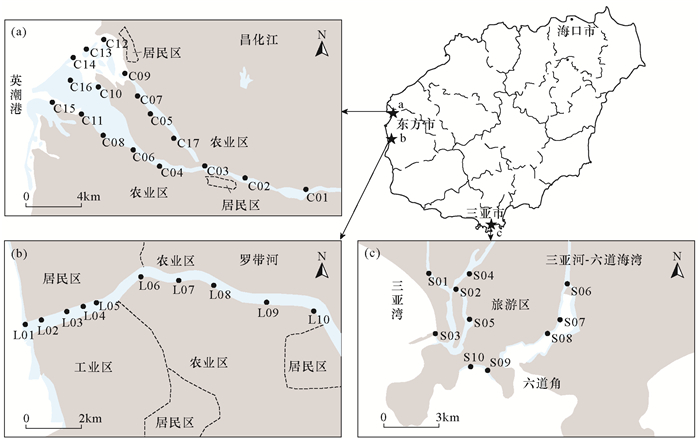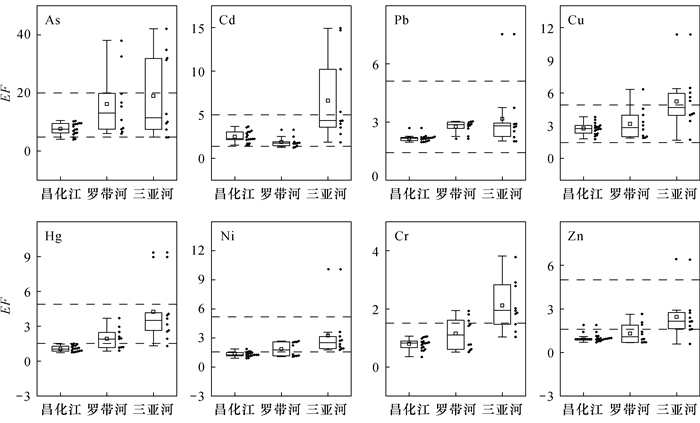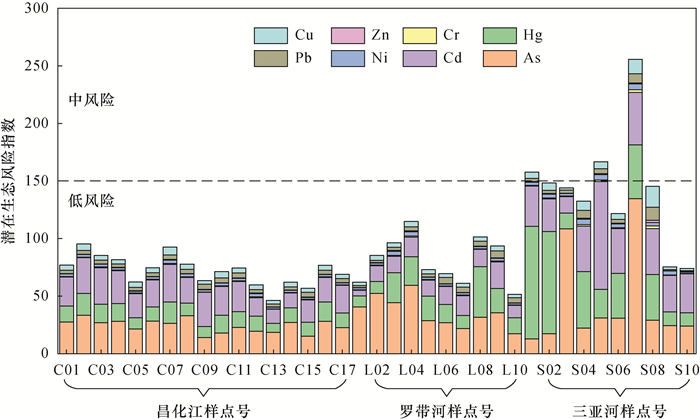Accumulation and Ecological Risk of Heavy Metals and Polycyclic Aromatic Hydrocarbons (PAHs) in Surface Sediments from Typical Estuaries in Hainan Island
-
摘要:
重金属和多环芳烃具有致畸性、致癌性和致突变性,是生态研究和环境保护领域的热点。海南岛是中国首个生态文明试验区,城市化进程的不断加快会增加河口地区环境保护的压力。昌化江、罗带河和三亚河是海南岛重要的入海河流。目前缺少对昌化江和罗带河沉积物中重金属和多环芳烃的报道,对三亚河的相关研究结果也存在差异。为了解这三条河流河口表层沉积物中重金属和多环芳烃(PAHs)累积特征和生态风险,本文采用电感耦合等离子体质谱/发射光谱法(ICP-MS/OES)、原子荧光光谱法(AFS)测定重金属元素(As、Cd、Cr、Cu、Hg、Ni、Pb和Zn)含量,气相色谱-质谱法(GC-MS)测定PAHs含量。根据污染物组成和相关性探讨其来源,并利用潜在生态风险指数和沉积物环境质量标准进行风险评估。结果表明:①昌化江沉积物中重金属As、Cd、Cr、Cu、Hg、Ni、Pb和Zn的平均值分别为3.24、0.03、7.03、5.33、0.007、3.06、16.9和14.1mg/kg;罗带河对应重金属平均值为4.81、0.02、7.69、4.56、0.010、3.29、18.3和14.7mg/kg;三亚河对应重金属平均值为5.83、0.05、15.3、8.28、0.021、4.91、21.4和29.8mg/kg。除As外,重金属均低于或接近海南岛土壤基准值。三个河口区沉积物中的As以及三亚河中的Cd、Cu具有较高的富集因子,表明受人为因素影响较大,可能与周边农业活动有关;其余重金属具有较低的富集因子和较高的相关性,表明受区域地质背景控制;②昌化江、罗带河、三亚河沉积物中PAHs含量分别为3.48~56.6μg/kg、8.72~56.8μg/kg、6.41~573.9μg/kg,均以中低环为主,表明生物质的低温燃烧是PAHs的主要来源;③生态风险评价结果显示,研究区沉积物没有受到重金属和PAHs污染,均以低生态风险为主。本研究结果可为河口区污染物生态风险防控提供参考。
Abstract:BACKGROUND Heavy metals and polycyclic aromatic hydrocarbons (PAHs) are the ecological research focus because of their teratogenicity, carcinogenicity, and mutagenicity. Hainan Island is China's first ecological civilization pilot area, and the continuous acceleration of urbanization will increase the pressure on environmental protection in the estuary area. The Changhua River, the Luodai River, and the Sanya River are important seagoing rivers in Hainan Island. At present, there is a lack of reports on heavy metals and polycyclic aromatic hydrocarbons in the sediments of the Changhua and Luodai Rivers, and there are differences in the related research results of the Sanya River.
OBJECTIVES To understand the characteristics, source, and ecological risk of heavy metals and PAHs in surface sediments from the estuary of the Changhua, Luodai, and Sanya Rivers in Hainan Island.
METHODS Sediment samples from the three estuaries were collected. Inductively coupled plasma-mass spectrometry/optical emission spectrometry (ICP-MS/OES) and atomic fluorescence spectrometry were used to determine the content of heavy metals (As, Cd, Cr, Cu, Hg, Ni, Pb, Zn). Gas chromatography-mass spectrometry was used to determine the content of PAHs. Source apportionment was further explored based on the correlation analysis and composition of the contaminants, and the ecological risk evaluation was carried out with the potential ecological risk index (PERI) and sediment quality guidelines (SQGs).
RESULTS The average contents of As, Cd, Cr, Cu, Hg, Ni, Pb, and Zn in the sediments of Changhua River were 3.24, 0.03, 7.03, 5.33, 0.007, 3.06, 16.9, and 14.1mg/kg, respectively. The corresponding values of these metals in Luodai River were 4.81, 0.02, 7.69, 4.56, 0.010, 3.29, 18.3, and 14.7mg/kg, and the corresponding values in Sanya River were 5.83, 0.05, 15.3, 8.28, 0.021, 4.91, 21.4, and 29.8mg/kg. Exception to As, the concentration of other heavy metals in the sediments were below or close to the Hainan soil baseline, showing little heavy metals accumulation effect. The contents of PAHs in the sediment range from 3.48 to 56.6μg/kg, from 8.72 to 56.8μg/kg, and from 6.41 to 573.9μg/kg for the Changhua, Luodai, and Sanya River, respectively. Compared with other regions, the sediment PAHs content in the study area was relatively low.
CONCLUSIONS Arsenic in the estuarine sediments of the three rivers and Cd, Cu in the Sanya River are strongly influenced by anthropogenic factors, while the regional background mainly influences the remaining elements. PAHs originated mostly from the low-temperature combustion of biomass. The ecological risk evaluation demonstrates that the biotoxic effect of the heavy metals and PAHs is not obvious, mostly with low ecological risk. The present study on heavy metals and PAHs contamination in surface sediments of the three estuaries will provide a reference for future research.
-

-
表 1 分析指标检出限
Table 1. Detection limit of analyzed indicators
重金属元素 检出限 单位 PAHs化合物 检出限 单位 PAHs化合物 检出限 单位 As 1 μg/kg 萘(Nap) 10 μg/kg 苯并[a]蒽(BaA) 2 μg/kg Cd 30 mg/kg 苊烯(Acy) 4 μg/kg 䓛(Chry) 1 μg/kg Cr 5 mg/kg 苊(Ace) 3 μg/kg 苯并[b]荧蒽(BbF) 1 μg/kg Cu 1 mg/kg 芴(Flo) 3 μg/kg 苯并[k]荧蒽(BkF) 2 μg/kg Hg 0.5 mg/kg 菲(Phe) 2 μg/kg 苯并[a]芘(BaP) 1 μg/kg Ni 2 μg/kg 蒽(Ant) 1 μg/kg 茚并[1, 2, 3-c, d]芘(InP) 1 μg/kg Pb 2 mg/kg 荧蒽(Fla) 2 μg/kg 二苯并[a, h]蒽(DahA) 1 μg/kg Zn 4 mg/kg 芘(Pyr) 2 μg/kg 苯并[g, h, i]苝(BghiP) 1 μg/kg 表 2 不同地区河流和河口沉积物重金属含量
Table 2. Concentrations of heavy metals in river and estuary sediments from different regions
研究区域 参数 As
(mg/kg)Cd
(μg/kg)Cr
(mg/kg)Cu
(mg/kg)Hg
(μg/kg)Ni
(mg/kg)Pb
(mg/kg)Zn
(mg/kg)文献来源 昌化江 含量范围
(平均值)1.87~4.48
(3.24)16.4~43.5
(31.6)2.64~10.1
(7.03)3.75~8.25
(5.33)3.94~9.54
(6.77)2.22~4.23
(3.06)12.8~21.33
(16.9)9.00~29.4
(14.1)本文研究 变异系数 23.82% 25.90% 25.24% 20.95% 23.03% 18.18% 15.50% 32.38% 罗带河 含量范围
(平均值)2.35~7.96
(4.81)6.53~30.7
(19.4)4.52~13.2
(7.69)3.44~6.04
(4.56)4.81~21.9
(9.91)2.42~5.63
(3.29)8.51~29.3
(18.3)7.79~30.6
(14.7)本文研究 变异系数 37.23% 32.11% 42.48% 17.89% 52.12% 33.46% 38.84% 54.80% 三亚河 含量范围
(平均值)1.74~18.0
(5.83)19.1~124.8
(53.3)4.38~34.4
(15.3)2.45~22.1
(8.28)5.79~48.8
(21.1)2.00~7.17
(4.91)4.81~55.9
(21.4)5.48~86.3
(29.8)本文研究 变异系数 96.46% 51.65% 68.50% 75.22% 71.79% 35.23% 76.38% 79.83% 三亚河 平均含量 10.27 181 10.27 3.9 204 22.7 32.0 100.4 甘华阳等[11] 珠江河口 平均含量 18.23 840 55.19 42.89 100 - 44.61 135.87 Zhao等[9] 长江河口 平均含量 9.1 190 79.1 24.7 - 31.9 23.8 82.9 Wang等[19] 丽江 平均含量 18.3 970 43.62 31.72 390 22.95 42.8 129.33 Xiao等[20] 韩国Seomjin河流域 平均含量 13.9 260 62.7 30.4 55 30.5 29.7 150.4 Yang等[21] 伊朗Tajan河 平均含量 12.8 - 20 - - 8.2 - 19.7 Alahabadi等[22] 海南土壤 基准值 1.34 40 27.52 6.1 20 7.24 24.36 44.43 傅杨荣等[16] 中国浅海沉积物 平均含量 7.7 65 60 15 25 24 20 65 迟清华等[23] 表 3 沉积物重金属元素相关性分析
Table 3. Correlation coefficient of heavy metal elements in sediment
河流 重金属元素 As Cd Cr Cu Hg Ni Pb 昌化江 Cd 0.266 Cr 0.302 0.584** Cu 0.437 0.526* 0.715** Hg 0.521* 0.603** 0.689** 0.697** Ni 0.232 0.321 0.804** 0.637** 0.503 Pb -0.356 0.457 0.395 0.268 0.116 0.200 Zn -0.019 0.387 0.640** 0.631** 0.422 0.808** 0.437 罗带河 Cd 0.256 Cr -0.656* -0.415 Cu 0.391 0.538 0.038 Hg -0.319 -0.137 0.629* 0.329 Ni -0.192 -0.034 0.758** 0.594* 0.613* Pb 0.203 0.325 0.095 0.309 0.213 0.417 Zn -0.222 -0.016 0.636* 0.411 0.950** 0.725** 0.356 三亚河 Cd -0.050 Cr 0.698* -0.349 Cu -0.544 0.061 -0.076 Hg 0.155 0.274 0.205 -0.148 Ni -0.091 -0.400 0.176 -0.032 -0.139 Pb 0.143 -0.181 0.638* 0.088 0.402 0.280 Zn 0.067 -0.243 0.573* 0.083 0.157 0.196 0.938** 注:“*”表示P<0.05,“**”表示P<0.01。 表 4 2015年以来报道的国内外不同河流(口)、湖泊、海洋沉积物PAHs含量对比
Table 4. Comparison of PAHs content in different rivers (estuaries), lakes and marine sediments since 2015
研究年份 研究区域 PAHs含量
(μg/kg)参考文献 2020 昌化江河口 3.48~56.6 本文研究 2020 罗带河河口 8.72~56.8 本文研究 2020 三亚河河口 6.41~573.9 本文研究 2019 三亚河 265~2735 詹咏等[13] 2016 三亚河 3.23~493 何书海等[12] 2018 胡格利河口(印度) 3.3~630 Mitra等[10] 2017 长江河口 89.52~208.02 Liu等[9] 2015 太湖 0.77~4.20 康杰等[28] 2016 白洋淀 163.20~861.43 高秋生等[29] 2015 南海北部沉积物 10.69-66.45 Kaiser等[30] -
[1] Kim I, Kim Y, Kim R, et al. Spatial distribution, origin and contamination assessment of heavy metals in surface sediments from Jangsong Tidal Flat, Kangryong River Estuary, DPR Korea[J]. Marine Pollution Bulletin, 2021, 168: 112414. doi: 10.1016/j.marpolbul.2021.112414
[2] 沈小明, 吕爱娟, 沈加林, 等. 长江口启东—崇明岛航道沉积物中多环芳烃分布来源及生态风险评价[J]. 岩矿测试, 2014, 33(3): 374-380. http://www.ykcs.ac.cn/cn/article/id/9865b25e-a1b9-47c1-9abd-9aec581dfaa4
Shen X M, Lyu A J, Shen J L, et al. Distribution characteristics, sources and ecological risk assessment of polycyclic aromatic hydrocarbons in waterway sediments from Qidong and Chongming Island of Yangtze River Estuary[J]. Rock and Mineral Analysis, 2014, 33(3): 379-385. http://www.ykcs.ac.cn/cn/article/id/9865b25e-a1b9-47c1-9abd-9aec581dfaa4
[3] He Z F, Li F L, Dominech S, et al. Heavy metals of surface sediments in the Changjiang (Yangtze River) Estuary: Distribution, speciation and environmental risks[J]. Journal of Geochemical Exploration, 2019, 198: 18-28. doi: 10.1016/j.gexplo.2018.12.015
[4] 马生明, 朱立新, 汤丽玲, 等. 城镇周边和江河沿岸土壤中Hg和Cd存在形式解析与生态风险评估[J]. 岩矿测试, 2020, 39(2): 225-234. http://www.ykcs.ac.cn/cn/article/doi/10.15898/j.cnki.11-2131/td.201906060081
Ma S M, Zhu L X, Tang L L, et al. The occurrences of Hg and Cd in soils around cities and rivers and their ecological risk assessment[J]. Rock and Mineral Analysis, 2020, 39(2): 225-234. http://www.ykcs.ac.cn/cn/article/doi/10.15898/j.cnki.11-2131/td.201906060081
[5] Rastegari M, Keshavarzi B, Moore F, et al. Spatial distribution, environmental risk and sources of heavy metals and polycyclic aromatic hydrocarbons (PAHs) in surface sediments—Northwest of Persian Gulf[J]. Continental Shelf Research, 2020, 193: 104036. doi: 10.1016/j.csr.2019.104036
[6] Zhuang W, Zhou F X. Distribution, source and pollution assessment of heavy metals in the surface sediments of the Yangtze River Estuary and its adjacent East China Sea[J]. Marine Pollution Bulletin, 2021, 164: 112002. doi: 10.1016/j.marpolbul.2021.112002
[7] Liu M, Chen J B, Sun X S, et al. Accumulation and transformation of heavy metals in surface sediments from the Yangtze River Estuary to the East China Sea shelf[J]. Environmental Pollution, 2019, 245: 111-121. doi: 10.1016/j.envpol.2018.10.128
[8] Mitra S, Corsolini S, Pozo K, et al. Characterization, source identification and risk associated with polyaromatic and chlorinated organic contaminants (PAHs, PCBs, PCBs and OCPs) in the surface sediments of Hooghly Estuary, India[J]. Chemosphere, 2019, 221: 154-165. doi: 10.1016/j.chemosphere.2018.12.173
[9] Zhao G M, Ye S Y, Yuan H M, et al. Surface sediment properties and heavy metal contamination assessment in river sediments of the Pearl River Delta, China[J]. Marine Pollution Bulletin, 2018, 136: 300-308. doi: 10.1016/j.marpolbul.2018.09.035
[10] Liu X P, Chen Z W, Xia C F, et al. Characteristics, distribution, source and ecological risk of polycyclic aromatic hydrocarbons (PAHs) in sediments along the Yangtze River Estuary deepwater channel[J]. Marine Pollution Bulletin, 2019, 150(1-2): 110765.
[11] 甘华阳, 何海军, 张卫坤, 等. 三亚河沉积物中重金属生态风险评价与污染历史[J]. 生态环境学报, 2015, 24(11): 1878-1885. https://www.cnki.com.cn/Article/CJFDTOTAL-TRYJ201511019.htm
Gan H Y, He H J, Zhang W K, et al. Eco-risk assessment and contamination history of heavy metals in the sediments of Sanya River[J]. Ecology and Environmental Sciences, 2015, 24(11): 1878-1885. https://www.cnki.com.cn/Article/CJFDTOTAL-TRYJ201511019.htm
[12] 何书海, 曹小聪, 李腾崖, 等. 三亚河表层沉积物中多环芳烃分布、来源解析及生态风险评价[J]. 环境化学, 2019, 38(4): 967-970. https://www.cnki.com.cn/Article/CJFDTOTAL-HJHX201904030.htm
He S H, Cao X C, Li T Y, et al. Distribution, source and ecological risk assessment of polycyclic aromatic hydrocarbons (PAHs) in surface sediments from Sanya River[J]. Environmental Chemistry, 2019, 38(4): 967-970. https://www.cnki.com.cn/Article/CJFDTOTAL-HJHX201904030.htm
[13] 詹咏, 韦婷婷, 叶汇彬, 等. 三亚河沉积物PAHs和PCBs的分布、来源及风险评价[J]. 环境科学, 2021, 42(4): 1830-1838. https://www.cnki.com.cn/Article/CJFDTOTAL-HJKZ202104027.htm
Zhan Y, Wei T T, Ye H B, et al. Distribution, source, and ecological risk evaluation of the PAHs and PCBs in the sediments from Sanya River[J]. Environmental Science, 2021, 42(4): 1830-1838. https://www.cnki.com.cn/Article/CJFDTOTAL-HJKZ202104027.htm
[14] 张勤, 白金峰, 王烨. 地壳全元素配套分析方案及分析质量监控系统[J]. 地学前缘, 2012, 19(3): 33-42. https://www.cnki.com.cn/Article/CJFDTOTAL-DXQY201203004.htm
Zhang Q, Bai J F, Wang Y. Analytical scheme and quality monitoring system for China geochemical baselines[J]. Earth Science Frontiers, 2012, 19(3): 33-42. https://www.cnki.com.cn/Article/CJFDTOTAL-DXQY201203004.htm
[15] Hakanson L. An ecological risk index for aquatic pollu-tion control: A sedimentological approach[J]. Water Research, 1980, 14(8): 975-1001. doi: 10.1016/0043-1354(80)90143-8
[16] 傅杨荣, 杨奕, 何玉生, 等. 中华人民共和国多目标区域地球化学调查报告——海南岛[R]. 海口: 海南省地质调查院, 2008.
Fu Y R, Yang Y, He Y S, et al. Multi-purpose regional geochemical report of Hainan Island[R]. Haikou: Hainan Institute of Geological Survey, 2008.
[17] Zoller W H, Gladney E S, Duce R A. Atmospheric con-centrations and sources of trace metals at the South Pole[J]. Science, 1974, 183(4121): 198-200. doi: 10.1126/science.183.4121.198
[18] Baumard P, Garrigues, Garrigues P. Polycyclic aromatic hydrocarbons in sediments and mussels of the western Mediterranean Sea[J]. Environmental Toxicology and Chemistry, 1998, 5: 765-776.
[19] Wang H T, Wang J W, Liu R M, et al. Spatial variation, environmental risk and biological hazard assessment of heavy metals in surface sediments of the Yangtze River Estuary[J]. Marine Pollution Bulletin, 2015, 93(1-2): 250-258. doi: 10.1016/j.marpolbul.2015.01.026
[20] Xiao H, Shahab A, Xi B D, et al. Heavy metal pollution, ecological risk, spatial distribution, and source identification in sediments of the Lijiang River, China[J]. Environmental Pollution, 2021, 269: 116189. doi: 10.1016/j.envpol.2020.116189
[21] Yang H J, Bong K M, Kang T, et al. Assessing heavy metals in surface sediments of the Seomjin River Basin, South Korea, by statistical and geochemical analysis[J]. Chemosphere, 2021, 284: 131400. doi: 10.1016/j.chemosphere.2021.131400
[22] Alahabadi A, Malvandi H. Contamination and ecological risk assessment of heavy metals and metalloids in surface sediments of the Tajan River, Iran[J]. Marine Pollution Bulletin, 2018, 133: 741-749. doi: 10.1016/j.marpolbul.2018.06.030
[23] 迟清华, 鄢明才. 应用地球化学元素丰度数据手册[M]. 北京: 地质出版社, 2007.
Chi Q H, Yan M C. Handbook of applied geochemical element abundance data[M]. Beijing: Geological Publishing House, 2007.
[24] 张富贵, 彭敏, 王惠艳, 等. 基于乡镇尺度的西南重金属高背景区土壤重金属生态风险评价[J]. 环境科学, 2020, 41(9): 4197-4209. https://www.cnki.com.cn/Article/CJFDTOTAL-HJKZ202009038.htm
Zhang F G, Peng M, Wang H Y, et al. Ecological risk assessment of heavy metals at township scale in the high background of heavy metals, southwestern China[J]. Environmental Science, 2020, 41(9): 4197-4209. https://www.cnki.com.cn/Article/CJFDTOTAL-HJKZ202009038.htm
[25] 王瑞霖, 程先, 孙然好. 海河流域中南部河流沉积物的重金属生态风险评价[J]. 环境科学, 2014, 35(10): 3740-3747. https://www.cnki.com.cn/Article/CJFDTOTAL-HJKZ201410016.htm
Wang R L, Cheng X, Sun R H. Ecological risk assessment of heavy metals in surface sediments in the southern and central Haihe River Basin[J]. Environmental Science, 2014, 35(10): 3740-3747. https://www.cnki.com.cn/Article/CJFDTOTAL-HJKZ201410016.htm
[26] Chen R, Zhang Q, Chen H, et al. Source apportionment of heavy metals in sediments and soils in an interconnected river-soil system based on a composite fingerprint screening approach[J]. Journal of Hazardous Materials, 2021, 411: 125125. doi: 10.1016/j.jhazmat.2021.125125
[27] Li M Y, Zhang Q G, Sun X J, et al. Heavy metals in surface sediments in the trans-Himalayan Koshi River catchment: Distribution, source identification and pollution assessment[J]. Chemosphere, 2020, 244: 125410. doi: 10.1016/j.chemosphere.2019.125410
[28] 康杰, 胡健, 朱兆洲, 等. 太湖及周边河流表层沉积物中PAHs的分布、来源与风险评价[J]. 中国环境科学, 2017, 37(3): 1162-1170. https://www.cnki.com.cn/Article/CJFDTOTAL-ZGHJ201703044.htm
Kang J, Hu J, Zhu Z Z, et al. Distribution, source and risk assessment of PAHs in surface sediments from Taihu Lake and its surrounding rivers[J]. China Environmental Science, 2017, 37(3): 1162-1170. https://www.cnki.com.cn/Article/CJFDTOTAL-ZGHJ201703044.htm
[29] 高秋生, 焦立新, 杨柳, 等. 白洋淀典型持久性有机污染物污染特征与风险评估[J]. 环境科学, 2018, 39(4): 1616-1627. https://www.cnki.com.cn/Article/CJFDTOTAL-HJKZ201804021.htm
Gao Q S, Jiao L X, Yang L, et al. Occurrence and ecological risk assessment of typical persistent organic pollutants in Baiyangdian Lake[J]. Environmental Science, 2018, 39(4): 1616-1627. https://www.cnki.com.cn/Article/CJFDTOTAL-HJKZ201804021.htm
[30] Kaiser D, Schulz-Bull D E, Waniek J J. Polycyclic and organochlorine hydrocarbons in sediments of the northern South China Sea[J]. Marine Pollution Bulletin, 2018, 137: 668-676. doi: 10.1016/j.marpolbul.2018.10.039
[31] 刘红, 何青, 王元叶, 等. 长江口表层沉积物粒度时空分布特征[J]. 沉积学报, 2007, 25(3): 445-455. doi: 10.3969/j.issn.1000-0550.2007.03.017
Liu H, He Q, Wang Y Y, et al. Temporal and spatial characteristics of surface sediment grain size distribution in Changjiang Estuary[J]. Acta Sedimentologica Sinica, 2007, 25(3): 445-455. doi: 10.3969/j.issn.1000-0550.2007.03.017
[32] 王洪涛, 张俊华, 丁少峰, 等. 开封城市河流表层沉积物重金属分布、污染来源及风险评估[J]. 环境科学学报, 2016, 36(12): 4520-4530. https://www.cnki.com.cn/Article/CJFDTOTAL-HJXX201612026.htm
Wang H T, Zhang J H, Ding S F, et al. Distribution characteristics, sources identification and risk assessment of heavy metals in surface sediments of urban rivers in Kaifeng[J]. Acta Scientiae Circumstantiae, 2016, 36(12): 4520-4530. https://www.cnki.com.cn/Article/CJFDTOTAL-HJXX201612026.htm
[33] Li Q, Wu J, Zhou J, et al. Occurrence of polycyclic aromatic hydrocarbon (PAH) in soils around two typical lakes in the western Tian Shan Mountains (Kyrgyzstan, Central Asia): Local burden or global distillation?[J]. Ecological Indicators, 2020, 108: 105749. doi: 10.1016/j.ecolind.2019.105749
[34] Field R A, Lester J N, Baek S O, et al. A review of atmospheric polycyclic aromatic hydrocarbons: Sources, fate and behavior[J]. Water Air and Soil Pollution, 1991, 60(3-4): 279-300. doi: 10.1007/BF00282628
[35] Agarwal T, Khillare P S, Shridhar V, et al. Pattern, sources and toxic potential of PAHs in the agricultural soils of Delhi, India[J]. Journal of Hazardous Materials, 2009, 163(2): 1033-1039.
[36] Li S Y, Tao Y Q, Yao S C, et al. Distribution, sources, and risks of polycyclic aromatic hydrocarbons in the surface sediments from 28 lakes in the middle and lower reaches of the Yangtze River region, China[J]. Environmental Science and Pollution Research, 2016, 23(5): 4812-4825. doi: 10.1007/s11356-015-5705-y
-




 下载:
下载:


